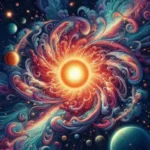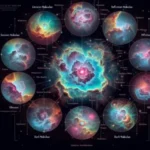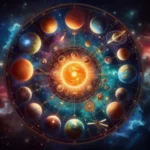The universe, with its vast expanse of twinkling lights and celestial wonders, has captivated human imagination for centuries.
Among its most enchanting phenomena are stars, those brilliant orbs of gas that not only light up our night skies but also hold the secrets to the cosmos itself. In “The Cosmic Journey: Unveiling the evolution of Stars Over Time,” we embark on an awe-inspiring exploration of how these stellar giants are born, evolve, and ultimately meet their dramatic ends. From the fiery birth in stellar nurseries to their breathtaking supernova explosions, the life cycle of a star is a testament to the intricate dance of cosmic forces. Join us as we delve into the science behind stellar evolution, uncovering the remarkable transformations that take place over billions of years, and learn how these cosmic milestones shape the very fabric of our universe. Whether you’re an astronomy enthusiast or a curious newcomer to the wonders of space, this journey through the life of stars promises to illuminate your understanding of the cosmos in ways you never imagined.
1. Introduction to the Cosmic Journey
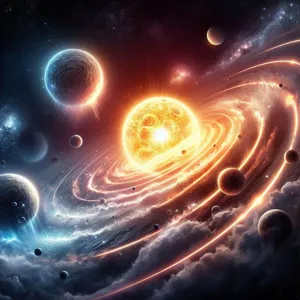
The universe, a vast expanse of mystery and intrigue, has fascinated humanity for millennia. Among its most captivating features are the stars, those shimmering points of light that have inspired countless myths, art, and scientific inquiry. They are not just beautiful celestial bodies; they are dynamic entities that undergo remarkable transformations over billions of years. In this section, we embark on a cosmic journey, exploring the intricate processes that govern the life cycle of stars and how they evolve through time.
From their humble beginnings in swirling clouds of gas and dust, to their explosive deaths as supernovae, stars tell a story of creation, destruction, and rebirth. Each stage in a star’s life is marked by profound changes that influence not only the star itself but also the surrounding universe. As we delve into the cosmic journey of stars, we will uncover the secrets of stellar formation, the various types of stars, and the forces that drive their evolution. We will also examine how these celestial giants contribute to the fabric of the cosmos, seeding the universe with the elements necessary for life.
Join us as we illuminate the path of stars, revealing how these incredible cosmic travelers navigate the vastness of space and time. Prepare to be awed by the beauty of their transformations and the intricate dance of physics and chemistry that shapes the universe we inhabit.
2. What Are Stars? An Overview of Stellar Formation
Stars are the magnificent celestial bodies that illuminate our night sky, forged from the very fabric of the universe itself. At their core, stars are massive spheres of hot plasma, primarily composed of hydrogen and helium, undergoing a process of nuclear fusion that generates immense energy. This intricate dance of particles not only produces light but also sustains the life cycles of the universe.
The journey of a star begins in the vast expanses of space within molecular clouds, also known as stellar nurseries. These dense regions of gas and dust provide the necessary conditions for stellar formation. Over time, gravitational forces cause these clouds to collapse in on themselves, leading to the birth of a protostar. As the material gathers, the protostar’s core heats up, and once the temperature reaches millions of degrees, nuclear fusion ignites, marking the star’s official entry into the main sequence phase.
During this phase, stars spend the majority of their lifetimes, fusing hydrogen into helium in their cores and radiating energy outward. This balance between gravity pulling inward and the outward pressure from nuclear reactions is what keeps a star stable. The size and mass of a star determine its color, temperature, and lifespan. Massive stars may burn brightly for just a few million years, while smaller stars, like our Sun, can shine for billions of years.
As a star ages, it undergoes dramatic transformations. Once the hydrogen in its core is depleted, the star will expand into a red giant, eventually shedding its outer layers and leaving behind a dense core known as a white dwarf, or, if it’s massive enough, it may explode in a supernova, scattering elements across the cosmos and giving birth to new stars, planets, and even life itself.
The life cycle of a star is not just a fascinating tale of cosmic evolution; it is a testament to the intricate connections within the universe, where the birth and death of these celestial giants hold the keys to understanding the origins of matter and the formation of galaxies. As we delve deeper into the cosmic journey of stars, we uncover the profound processes that shape our universe and, ultimately, our existence.
3. The Birth of Stars: Nebulae and Protostars
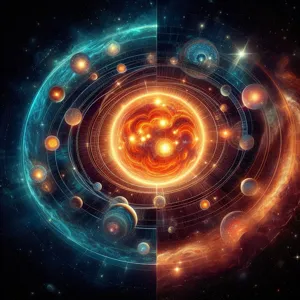
The birth of stars is a mesmerizing process that unfolds over millions of years, beginning in the vast, cold expanses of space where massive clouds of gas and dust, known as nebulae, reside. These nebulae, often colorful and ethereal, are the stellar nurseries of the universe, harboring the essential ingredients for star formation: hydrogen, helium, and trace amounts of heavier elements. Within these clouds, regions of higher density can trigger the celestial dance that leads to the birth of a star.
As gravitational forces pull these particles together, they begin to clump, and the temperature within these regions begins to rise. Over time, this accumulation forms a protostar, a dense sphere of gas that continues to gather mass while slowly rotating. The energy generated from the gravitational collapse heats the protostar’s core, and as the temperature escalates to millions of degrees, the conditions become ripe for nuclear fusion to ignite. This moment marks a pivotal transition in a star’s life cycle.
Surrounded by a rotating disk of gas and dust, the protostar is still somewhat obscured and shrouded in mystery, often hidden from our view by the very material that birthed it. However, as fusion begins, it emits energy and light, breaking free from the veil of darkness. The protostar evolves, shedding excess material and gradually becoming clearer to observers. This radiant display heralds the dawn of a new star, illuminating the cosmos and contributing to the intricate tapestry of the universe.
As these stars emerge from their nebulous wombs, they embark on a journey that will see them evolve through various stages of life, exhibiting a stunning array of characteristics influenced by their mass, composition, and the environment around them. The birth of stars, a true cosmic marvel, sets the stage for the formation of galaxies, planetary systems, and potentially, life itself. Through the lens of time, we witness not just the creation of stars, but the very foundation of the universe as we know it.
4. The Main Sequence: Life in the Stellar Spotlight
The Main Sequence: Life in the Stellar Spotlight
In the grand theater of the universe, stars take center stage during a significant phase known as the Main Sequence. This remarkable chapter in a star’s life is akin to a vibrant middle act in a cosmic play, lasting millions to billions of years, depending on the star’s mass. During this time, stars are in their prime, fusing hydrogen into helium in their cores—a process that releases an incredible amount of energy and light, allowing them to shine brightly against the backdrop of space.
Picture a massive, radiant giant like our Sun, gracefully balanced in a state of hydrostatic equilibrium. The immense gravitational forces pulling inward are countered by the outward pressure generated from nuclear fusion. This balance is critical; it not only sustains the star’s luminosity but also dictates its stability and longevity. Stars in the Main Sequence exhibit a variety of colors and temperatures, ranging from the cool, reddish hues of smaller stars to the intense, blue brilliance of their more massive counterparts. Each color tells a tale of its temperature, age, and the unique journey it has embarked on.
As we delve deeper into this phase, we find that the Main Sequence is not merely a time of idleness; it is a period of dynamic evolution. Stars gradually consume their hydrogen fuel, leading to subtle changes in their structure and brightness over time. As they near the end of this phase, the core begins to contract, causing temperatures to rise until they become hot enough to ignite helium fusion. This transition marks the end of their Main Sequence life and the beginning of an exciting evolution into the next stages of their existence.
In essence, the Main Sequence is a testament to the stellar life cycle, a phase where stars shine the brightest and contribute significantly to the fabric of the universe. As they bask in the luminosity of this stellar spotlight, they not only illuminate the cosmos but also forge the heavier elements that will one day be essential for the formation of planets and life as we know it. It is a period of both glory and transformation, setting the stage for the remarkable journeys that await each star in the vast expanse of the universe.
5. The Role of Fusion: How Stars Generate Energy
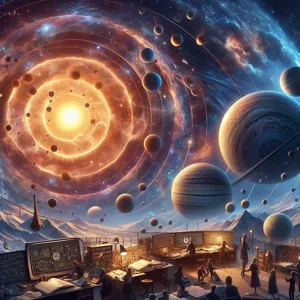
At the heart of every star lies a dazzling process known as nuclear fusion, a magnificent dance of particles taking place under extreme pressures and temperatures. This powerful phenomenon is the cornerstone of a star’s existence, enabling it to shine brightly for billions of years. In the core of a star, hydrogen atoms collide with such intensity that they overcome their natural repulsion and fuse together, forming helium. This fusion process releases an incredible amount of energy in the form of light and heat, propelling the star through its life cycle.
As stars evolve, they progress through various stages that are dictated by their mass. For instance, medium-sized stars like our Sun will eventually exhaust their hydrogen fuel, leading them to swell into red giants. During this phase, the fusion process will shift gears, allowing helium to fuse into carbon and oxygen. In contrast, massive stars will undergo a more chaotic evolution, cycling through a series of fusion processes that create heavier elements, ultimately culminating in a spectacular supernova explosion.
The energy produced by fusion not only fuels a star’s luminosity but also influences its internal structure and stability. The balance between the outward pressure from fusion energy and the inward pull of gravity ensures that stars remain in a delicate equilibrium. When this balance is disrupted—whether due to running out of fuel or the onset of a new fusion cycle—the fate of the star can change dramatically. The remnants of these stellar processes contribute to the cosmic landscape, seeding the universe with the elements necessary for the formation of planets, life, and subsequent generations of stars.
In essence, the role of fusion is not merely a source of energy; it is the very heartbeat of stars. It is the mechanism through which they evolve, shaping their destinies and influencing the cosmos as we know it. As we journey through the vast tapestry of the universe, understanding this stellar phenomenon allows us to appreciate the intricate connections between stars, elements, and the continued evolution of galaxies.
6. Stellar Evolution: From Red Giants to Supernovae
As stars age, they embark on a remarkable journey through various stages of stellar evolution, culminating in spectacular celestial events that illuminate the universe. One of the most fascinating phases in this lifecycle is the transformation from red giants to supernovae.
When a star exhausts the hydrogen fuel at its core, it begins to fuse helium into heavier elements, resulting in a significant increase in its size and a shift in color. This marks the transition into the red giant phase. Imagine a massive sphere of glowing gas, expanding to many times the size of its original form, its outer layers puffing out into brilliant hues of orange and red. During this stage, the star’s core contracts under gravity, heating up to the point where it initiates the fusion of heavier elements such as carbon and oxygen. The surrounding layers may shed, creating stunning planetary nebulae, while the core continues to collapse.
For stars with sufficient mass, this red giant phase is merely a precursor to a dramatic finale. Once the core becomes hot enough to fuse silicon into iron, the star reaches its limit. Unlike lighter elements, iron fusion does not yield energy; instead, it consumes energy. This leads to a catastrophic implosion of the core under its own gravity, followed by a violent explosion— a supernova. Picture an astronomical firework display, bright enough to outshine an entire galaxy for a brief moment. This explosion not only disperses heavy elements throughout the universe but also triggers the formation of new stars, creating a cosmic cycle of life and death.
Supernovae serve as the universe’s grand finale, enriching the interstellar medium with elements necessary for the formation of planets and life as we know it. The remnants of these stellar explosions may leave behind neutron stars or black holes, further contributing to the complex tapestry of the cosmos. In essence, the journey from red giants to supernovae highlights the continuous cycle of creation, destruction, and rebirth, showcasing the stunningly intricate evolution of stars over cosmic time.
7. The Death of Stars: White Dwarfs, Neutron Stars, and Black Holes
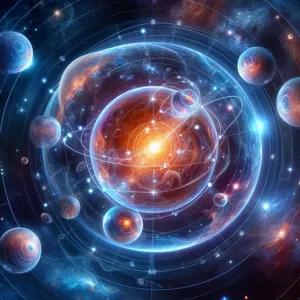
As stars approach the end of their life cycles, they undergo dramatic transformations that lead to their ultimate demise. This phase, often referred to as “the death of stars,” is as captivating as their birth and evolution. Depending on their initial mass, stars can end in one of three fascinating states: white dwarfs, neutron stars, or black holes.
**White Dwarfs**: For stars like our Sun, the death process culminates in the formation of a white dwarf. After exhausting their nuclear fuel, these medium-sized stars expel their outer layers, creating a stunning planetary nebula that can be observed across the cosmos. What remains is the core, a hot, dense remnant that gradually cools over time. A white dwarf is primarily composed of carbon and oxygen and shines solely from residual heat, a faint glimmer of its once vibrant life. Eventually, it will fade into obscurity, becoming a cold, dark relic of its former self.
**Neutron Stars**: In contrast, massive stars (those with at least eight times the mass of our Sun) face a more violent end. When these giants run out of fuel, they explode in a spectacular supernova that can outshine entire galaxies. The core that remains is an incredibly dense neutron star, where protons and electrons merge to form neutrons, packing a mass greater than that of the Sun into a sphere just a few kilometers wide. Neutron stars are fascinating entities, often spinning at incredible speeds and emitting beams of radiation, which can be detected as pulsars if their beams sweep across our line of sight.
**Black Holes**: The most enigmatic of stellar remnants are black holes, formed from the remnants of the most massive stars. If the core’s mass exceeds a critical limit, gravitational forces overpower all others, compressing the matter into a singularity—a point of infinite density where the laws of physics as we understand them cease to apply. The boundary surrounding this singularity is known as the event horizon, beyond which no light or information can escape. Black holes are not just cosmic vacuum cleaners but rather gateways to uncharted territories of space and time, challenging our understanding of the universe.
In contemplating the death of stars, we are reminded of the cosmic cycle of creation and destruction. Each end is not merely an end but a transformative process that contributes to the universe’s ongoing evolution. The remnants of stars—white dwarfs, neutron stars, and black holes—serve as the building blocks for new celestial bodies, illustrating how death begets life in the vast tapestry of the cosmos.
8. The Impact of Mass on Stellar Life Cycles
The impact of mass on stellar life cycles is profound and serves as a fundamental principle in our understanding of the cosmos. At the heart of this influence lies a star’s mass, which dictates not only its temperature and brightness but also its lifespan and ultimate fate. The life cycle of a star is akin to a grand performance, choreographed by gravitational forces and nuclear fusion reactions, with mass as the lead performer.
In the stellar nursery, massive stars emerge from vast clouds of gas and dust, their immense gravitational pull drawing in surrounding material. These high-mass stars, often more than eight times the mass of our Sun, burn through their nuclear fuel at a staggering rate, causing them to shine brightly and exhibit incredible luminosity. However, their rapid consumption of hydrogen means their lives are relatively short-lived, lasting just a few million years in contrast to the billions enjoyed by smaller stars. As they approach the end of their lifecycle, massive stars undergo dramatic transformations, leading to spectacular events such as supernova explosions, which can outshine entire galaxies for a brief moment. The remnants of these explosions scatter heavy elements across the universe, seeding the very building blocks of new stars, planets, and even life itself.
On the other end of the spectrum are low-mass stars, like our Sun, which burn their fuel slowly and steadily. These stars enjoy a much longer existence, living for tens of billions of years. As they age, they expand into red giants before shedding their outer layers, ultimately leaving behind a dense core known as a white dwarf. This process is more gentle compared to the cataclysmic end of massive stars, illustrating the stark differences shaped by mass.
In essence, the mass of a star not only determines its characteristics during its life but also influences its death, impacting the cosmic landscape for eons to come. Understanding this relationship helps astronomers piece together the intricate puzzle of stellar evolution and the evolution of the universe itself. As we gaze at the night sky, we are reminded that every twinkling star is a testament to the dynamic interplay of mass, time, and cosmic transformation.
9. The Formation of Stellar Clusters and Galaxies
As stars are born and live out their luminous lives, they often gather into groups, giving rise to stellar clusters and galaxies—grand collections of stars bound together by gravity. The formation of these cosmic structures is a fascinating process that unveils the intricate tapestry of the universe.
Stellar clusters are typically classified into two main types: open clusters and globular clusters. Open clusters, often found in the spiral arms of galaxies, consist of a few hundred to a few thousand stars that are loosely bound together. These clusters are relatively young, often containing hot, blue stars that light up the cosmos with their brilliance. Famous examples include the Pleiades and the Hyades clusters, which showcase the beauty of newly formed stars orbiting together in a stellar dance.
On the other hand, globular clusters are ancient, tightly packed collections of stars, often containing tens of thousands to hundreds of thousands of members. These clusters are typically found in the halo of galaxies, orbiting in a more chaotic manner compared to their open counterparts. Their stars are older, often redder, and provide a glimpse into the early universe, giving astronomers vital clues about the conditions that existed shortly after the Big Bang.
The formation of galaxies takes this process a step further. Galaxies, massive structures comprising billions of stars, gas, dust, and dark matter, form through the gravitational attraction of these stellar clusters. Initially, small clouds of gas and dust collapse under their own gravity, leading to the birth of stars. As these stars form, they begin to cluster together due to their gravitational pull, eventually merging with other clusters to create larger galactic structures.
Over billions of years, galaxies evolve through processes such as star formation, supernova explosions, and interactions with neighboring galaxies. These interactions can lead to spectacular events like galactic mergers, which can give rise to new stars and completely reshape the galactic landscape. This dynamic interplay of forces in the cosmos not only shapes the stars within but also influences the very structure of the universe itself.
Understanding the formation of stellar clusters and galaxies offers us a glimpse into the cosmic journey of stars over time. It reveals the beauty and complexity of the universe, where stars are not just solitary entities but integral parts of a grander cosmic narrative encompassing the birth, life, and death of celestial bodies. Each cluster and galaxy tells a story of its own, contributing to the ever-evolving tapestry of the cosmos.
10. The Role of Stars in the Cosmic Ecosystem
Stars are not merely radiant points of light scattered across the night sky; they are the fundamental building blocks of the universe, playing a pivotal role in the cosmic ecosystem. From their birth in swirling clouds of gas and dust to their spectacular deaths, stars are integral to the cycle of matter that sustains life and shapes galaxies.
When stars form from the gravitational collapse of interstellar gas and dust, they ignite nuclear fusion at their cores, converting hydrogen into helium and releasing immense amounts of energy in the form of light and heat. This process not only gives rise to the celestial bodies we observe but also enriches the surrounding material with heavier elements. During their lifetimes, stars act as cosmic forges, synthesizing elements such as carbon, oxygen, and iron through fusion processes. These elements are crucial for the formation of planets and, ultimately, life as we know it.
As stars reach the end of their lives, their fates diverge dramatically. Massive stars explode in cataclysmic supernovae, scattering their enriched contents across the cosmos, while smaller stars like our Sun swell into red giants before shedding their outer layers, creating stunning planetary nebulae. This dispersal of elements seeds the universe, contributing to the formation of new stars, planets, and potentially even life.
Moreover, stars influence the dynamics of galaxies. Their gravitational pull helps to maintain the structure of galaxies, while their light illuminates the dark expanses of space, allowing us to trace the history of cosmic evolution. The life cycle of stars, therefore, is not just a solitary journey; it is a collective saga that impacts the formation and evolution of the universe itself, illustrating the profound interconnectedness of all celestial phenomena.
In understanding the role of stars within this vast cosmic ecosystem, we gain insight into our own origins and the intricate web of relationships that binds the universe together, reminding us that we, too, are made of stardust.
11. How Stars Influence Planetary Systems
Stars are not merely celestial bodies illuminating the night sky; they are dynamic powerhouses that shape the very fabric of planetary systems. From their birth in sprawling nebulae to their fiery deaths, the life cycles of stars play a pivotal role in the evolution of planets and the potential for life within those systems.
In the early stages of a star’s life, the surrounding protoplanetary disk—a swirling mass of gas and dust—begins to coalesce into planets. The mass and energy emitted by the nascent star govern the conditions within this disk, determining the size, composition, and distance of forming planets. For instance, in a star system with a hotter, more massive star, we may find rocky planets like Earth situated closer to the star, while gas giants form further out where temperatures allow for the accumulation of lighter elements.
As stars progress through their life cycles, their influence continues to be felt throughout their planetary systems. During the main sequence phase, stars emit radiation that can either foster or hinder the development of life on nearby planets. The habitable zone, often referred to as the “Goldilocks zone,” is the region around a star where conditions may be just right for liquid water to exist—crucial for life as we know it.
When stars exhaust their nuclear fuel, they enter a dramatic phase of evolution. Massive stars explode in supernovae, dispersing heavy elements like carbon, oxygen, and iron into the cosmos. This stellar enrichment is essential for the formation of new stars and planetary systems. The remnants of these explosive events contribute to the building blocks of new worlds, ultimately influencing the chemistry and geology of future planets.
On the other hand, smaller stars, such as red dwarfs, have much longer lifespans, allowing them to host stable environments for billions of years. Their slow-burning nature can provide a consistent energy output that may support life for extended periods, making them prime candidates in the search for extraterrestrial life.
In short, the relationship between stars and their planetary systems is intricate and profound. Stars not only dictate the conditions for planet formation but also play a critical role in the ongoing evolution of those planets. Understanding this cosmic interplay helps us appreciate the delicate balance that allows life to flourish in the universe, as we continue to explore the vastness of space and the myriad of worlds it contains.
12. The Importance of Stellar Nucleosynthesis
Stellar nucleosynthesis is a cosmic alchemy that plays a pivotal role in the evolution of stars and, consequently, the very fabric of the universe. This fascinating process occurs within the cores of stars, where intense pressure and temperature facilitate nuclear reactions that convert lighter elements into heavier ones. It is here, amid the searing heat of fusion, that hydrogen atoms fuse to form helium, and through subsequent stages, elements like carbon, oxygen, and even iron emerge.
This process is not just a scientific curiosity; it is fundamental to our understanding of the universe. The elements forged in the hearts of stars are the building blocks of all matter, including the very components that make up our planet, our bodies, and the life that exists on Earth. Without stellar nucleosynthesis, the universe would be a barren expanse of hydrogen and helium, devoid of the complexity and diversity we see today.
As stars evolve, they undergo various phases, each contributing to a cycle of creation and destruction. Massive stars, for instance, end their lives in spectacular supernova explosions, scattering newly formed elements into the interstellar medium. This enriches the surrounding gas and dust with heavy elements, paving the way for the formation of new stars, planets, and eventually, life.
Stellar nucleosynthesis is a testament to the interconnectedness of the cosmos, illustrating how the life cycle of stars directly influences the evolution of galaxies and the very essence of matter itself. Understanding this process not only deepens our appreciation of the night sky but also highlights the remarkable journey of elements—from the fiery cores of stars to the delicate balance that sustains life on Earth.
13. Observing the Evolution of Stars: Tools and Techniques
Observing the evolution of stars is a celestial quest that requires a sophisticated blend of tools and techniques, allowing astronomers to peer into the vast expanse of the universe and unravel the mysteries of stellar lifecycles. At the heart of this exploration are powerful telescopes, both ground-based and space-based, equipped with advanced imaging technology that can capture the faintest light from distant stars. Instruments like the Hubble Space Telescope have revolutionized our understanding by providing unparalleled clarity and detail, revealing the intricate structures of nebulae and the remnants of supernovae.
In addition to telescopes, spectroscopes play a pivotal role in stellar observation. By analyzing the light emitted from stars, scientists can determine their composition, temperature, and velocity. This information is crucial for identifying where a star is in its evolutionary journey. For instance, the absorption and emission lines in a star’s spectrum can indicate whether it is in the main sequence phase, a red giant, or on the brink of a supernova explosion.
Moreover, computational models and simulations have become indispensable tools in studying stellar evolution. These sophisticated algorithms allow researchers to predict the life cycle of stars based on initial mass and composition, simulating thousands of scenarios to better understand how various factors influence their development. By comparing observational data with these models, astronomers can refine their theories and gain insights into the processes that govern stellar evolution.
Amateur astronomers are also contributing to this field, using smaller telescopes and online platforms to observe transient events such as nova eruptions or the dimming of stars due to exoplanet transits. Community-driven initiatives, like the Planet Hunters project, enable citizen scientists to analyze vast amounts of data, discovering new phenomena and adding to our collective knowledge of the cosmos.
As technology advances and our observational capabilities improve, the ability to study stars in real-time becomes increasingly feasible. Future missions, such as the James Webb Space Telescope, promise to unlock even deeper insights into the formation and evolution of stars, offering glimpses into the very origins of the universe itself. Through these tools and techniques, we embark on a cosmic journey that continually expands our understanding of the stellar lifecycle, illuminating the paths of stars from their fiery births to their dramatic deaths.
14. The Future of Stars: Predictions and Theories
As we gaze into the night sky, the shimmering points of light we see are not just distant suns, but rather the culmination of billions of years of cosmic evolution. But what does the future hold for these celestial wonders? Theories and predictions abound, each offering a glimpse into the life cycles that await our stellar neighbors.
In the coming billions of years, most stars will follow a predictable path. Our own Sun, a middle-aged G-type star, is set to transition into a red giant in about five billion years. During this phase, its outer layers will expand dramatically, potentially engulfing the inner planets, including Earth. Following this fiery transformation, the Sun will shed its outer layers, creating a stunning planetary nebula, while its core will collapse into a white dwarf—a dense, cooling remnant that will gradually fade into obscurity.
But not all stars share this fate. Massive stars, those with at least eight times the mass of our Sun, will meet a more explosive end. Upon exhausting their nuclear fuel, they will undergo a supernova explosion, a cataclysmic event that outshines entire galaxies for a brief moment. This explosion not only recycles elements back into the cosmos, enriching the interstellar medium with heavier elements, but can also leave behind intriguing remnants like neutron stars or black holes.
In the vast tapestry of the universe, the cycle of star formation continues. Regions of space filled with gas and dust will inevitably collapse under gravity, giving birth to new stars, some of which may host planets that could harbor life. The cosmic dance of creation and destruction unfolds endlessly, with each generation of stars contributing to the evolving chemistry of the universe.
Looking further into the future, scientists speculate about the long-term fates of stars and galaxies. Some theories suggest that, billions of years from now, our galaxy, the Milky Way, may collide with the Andromeda Galaxy, leading to a spectacular merger that will reshape the structure of both galaxies. As stars find themselves in new orbits and regions, the birth and death of stars will continue to create a dynamic, ever-changing cosmic landscape.
Furthermore, as we venture into the distant future, the universe itself is expanding at an accelerating rate. This means that, over trillions of years, galaxies will drift apart, and the night sky will gradually become darker. Stars will burn out, and the universe will transition into a cold, dark place dominated by faint remnants of once-vibrant celestial bodies.
While the future of stars may seem both wondrous and melancholic, it serves as a reminder of the intricate and beautiful processes that govern the cosmos. Each star, whether it shines brightly or fades into obscurity, plays a crucial role in the ongoing saga of the universe—an eternal journey of creation, transformation, and rebirth.
15. Conclusion: Our Place in the Cosmic Journey
As we draw our exploration of the cosmic journey to a close, it becomes increasingly clear that our understanding of stars and their evolution is not merely an academic pursuit; it is a profound reflection of our place in the universe. Each twinkling star we gaze upon in the night sky is a storyteller, whispering tales of creation, destruction, and rebirth over billions of years. From the fiery birth of a star in a nebula to its eventual demise in a spectacular supernova, the life cycle of stars is a reminder of the transient nature of existence.
Within this grand cosmic tapestry, we find ourselves on a tiny blue planet, orbiting a modest yellow star, the Sun. This Sun has nurtured life, influenced cultures, and ignited our thirst for knowledge. As we stand on the precipice of astronomical discovery, we are reminded that our actions and understanding have ramifications that extend far beyond our earthly realm. The elements forged in the cores of ancient stars are the very building blocks of life, connecting us to the cosmos in ways we are only beginning to comprehend.
In contemplating our place in this vast universe, we are inspired to continue our quest for knowledge. The evolution of stars not only reveals the processes that govern the cosmos but also invites us to reflect on our own journey. Just as stars undergo transformation, so too do we experience change throughout our lives. Each moment is a part of our own cosmic journey—a journey that is intrinsically linked to the stars above us.
As we conclude this exploration, let us carry forward the wonder and reverence for the universe that fuels our curiosity. The cosmic journey is ongoing, and as we look to the stars, we are reminded that we are both observers and participants in this magnificent saga. Together, we can unlock the mysteries of the universe, ensuring that the story of stars—and of humanity—continues to unfold for generations to come.
In conclusion, we hope this exploration of the cosmic journey through the evolution of stars has ignited your curiosity about the vast universe that surrounds us. From the fiery births of stars in nebulae to their majestic transformations into supernovae and beyond, each stage of a star’s life is a testament to the wonders of nature and the intricate processes that govern our cosmos. As we gaze up at the night sky, let us remember that those twinkling lights tell stories of immense change and resilience over billions of years. We invite you to continue your journey of discovery—whether through further reading, stargazing, or engaging in conversations about the universe. After all, the more we learn about the stars, the more we uncover about our own place in the vastness of space. Thank you for joining us on this stellar adventure!

